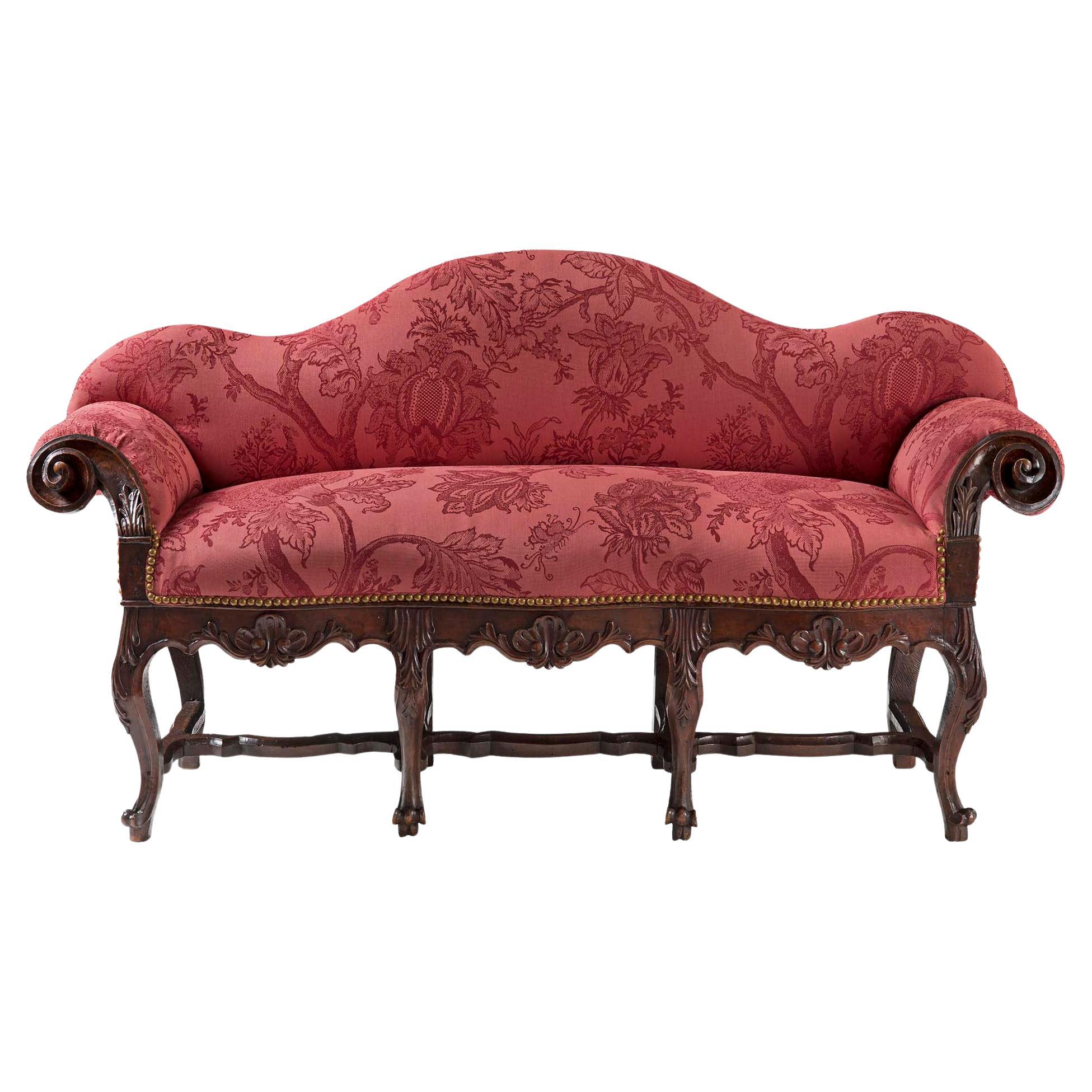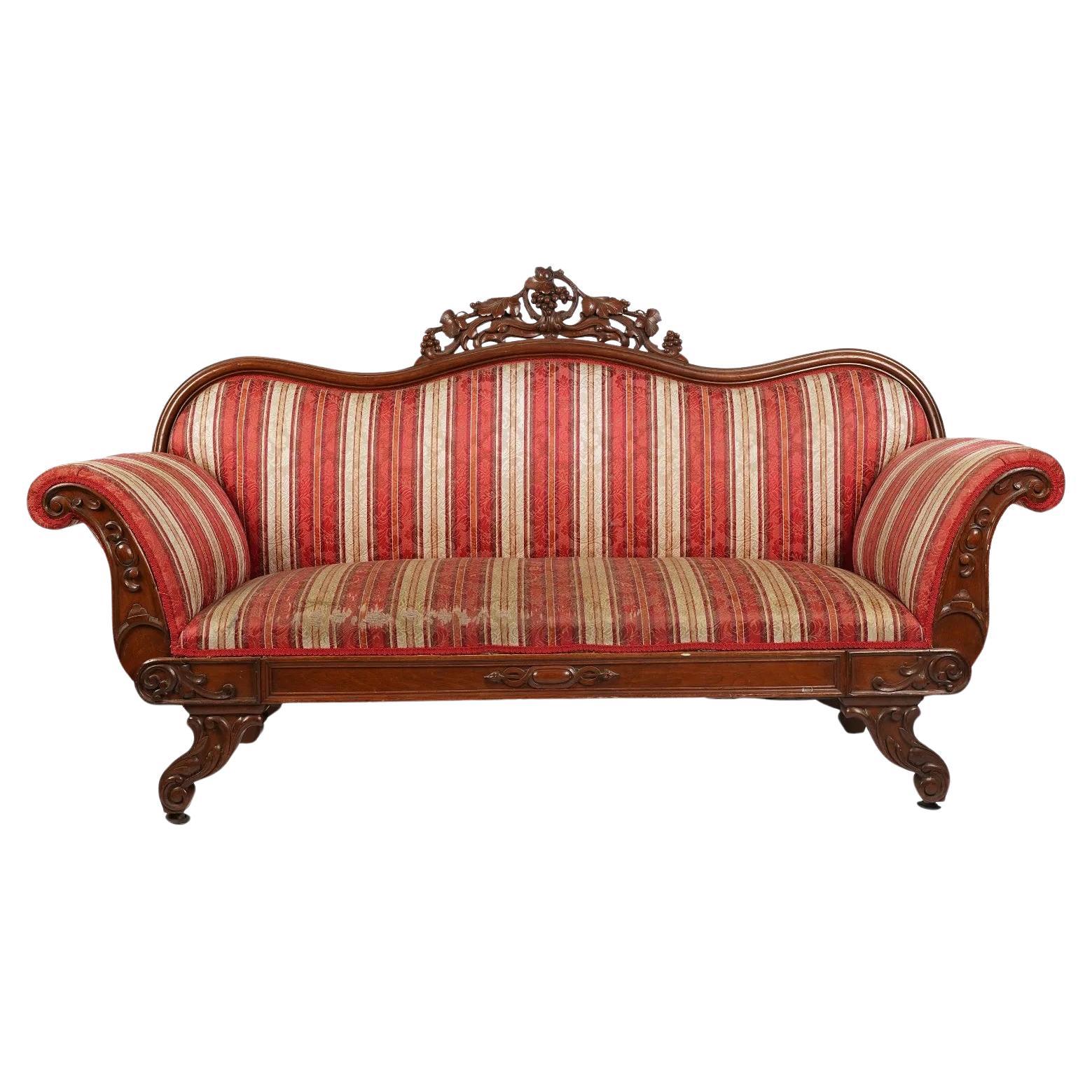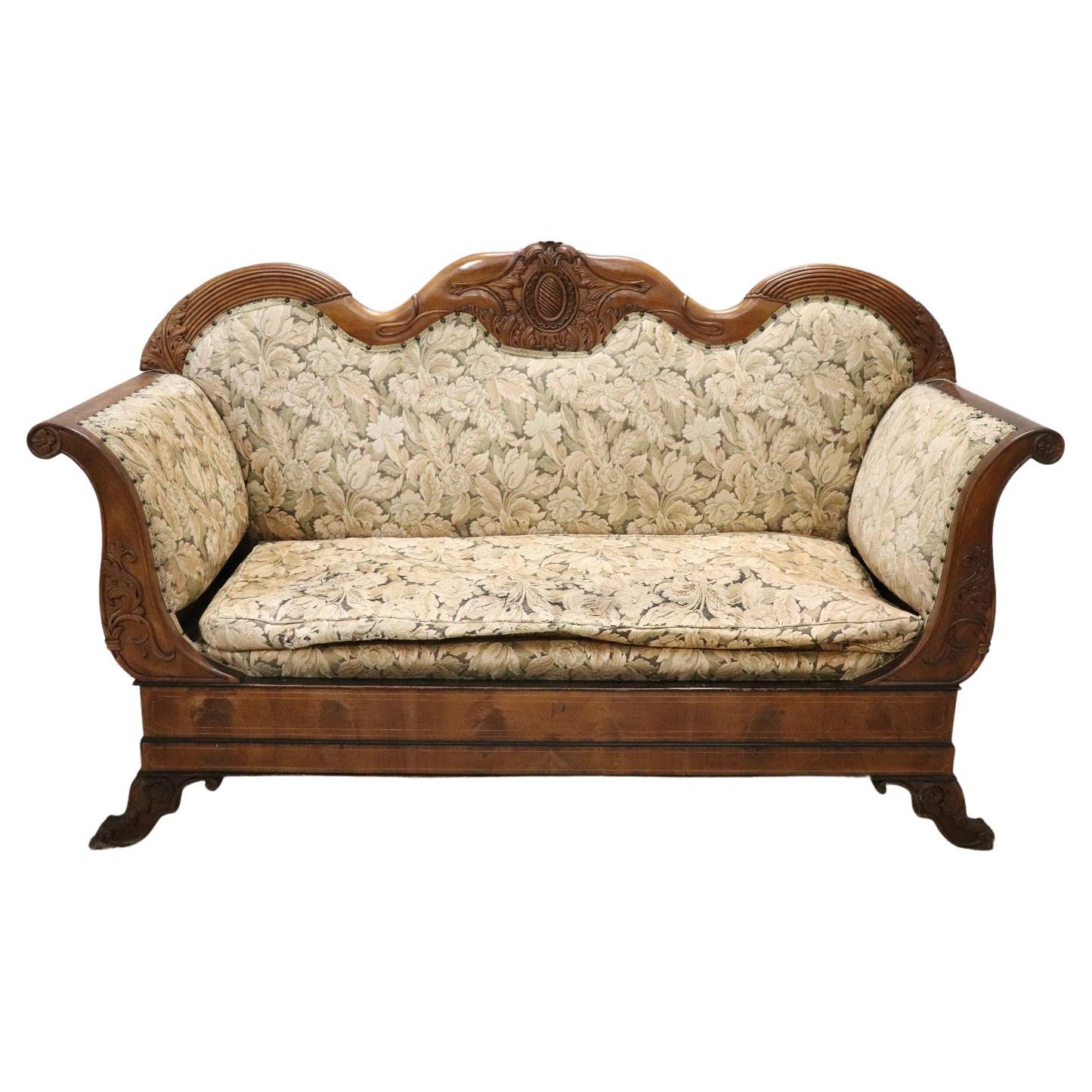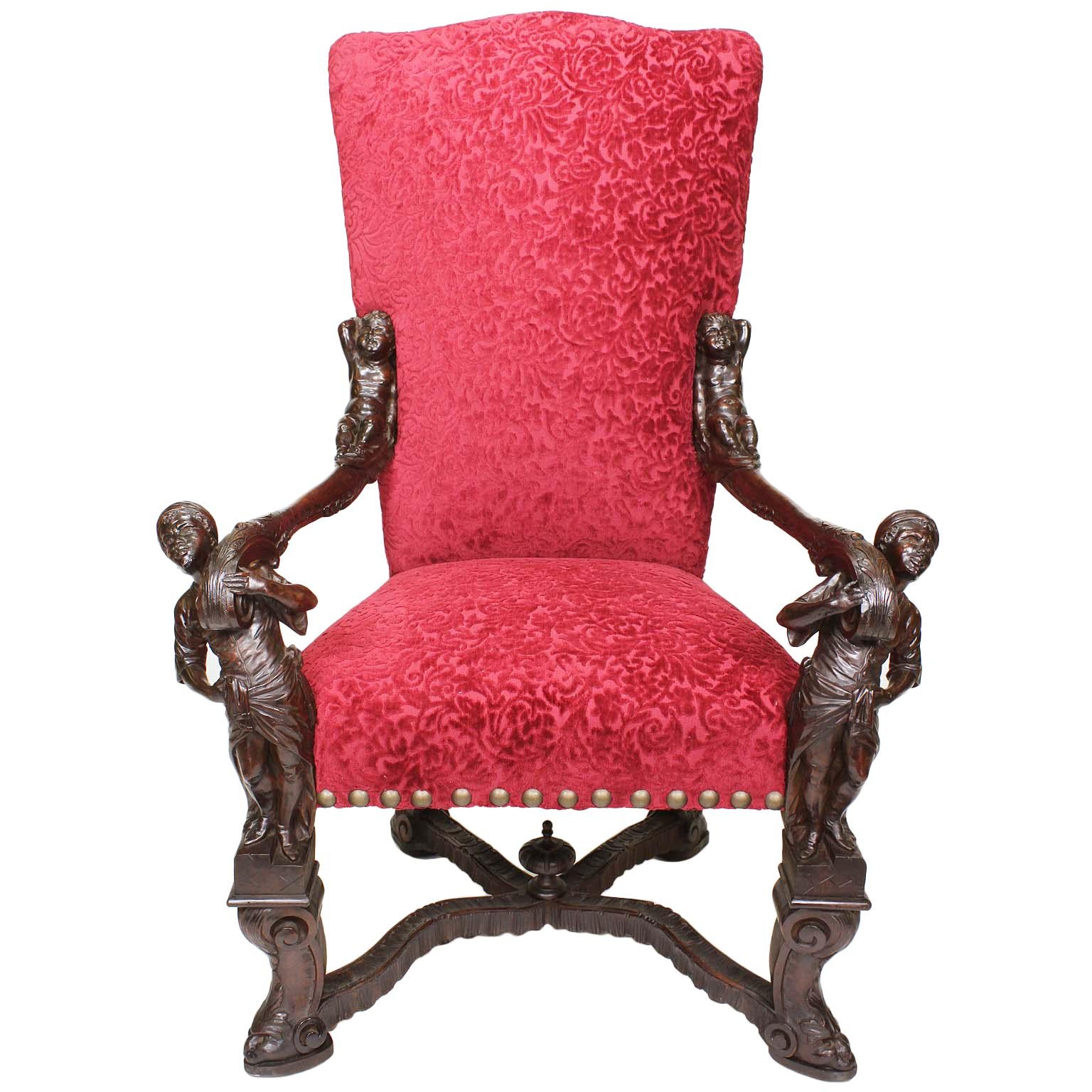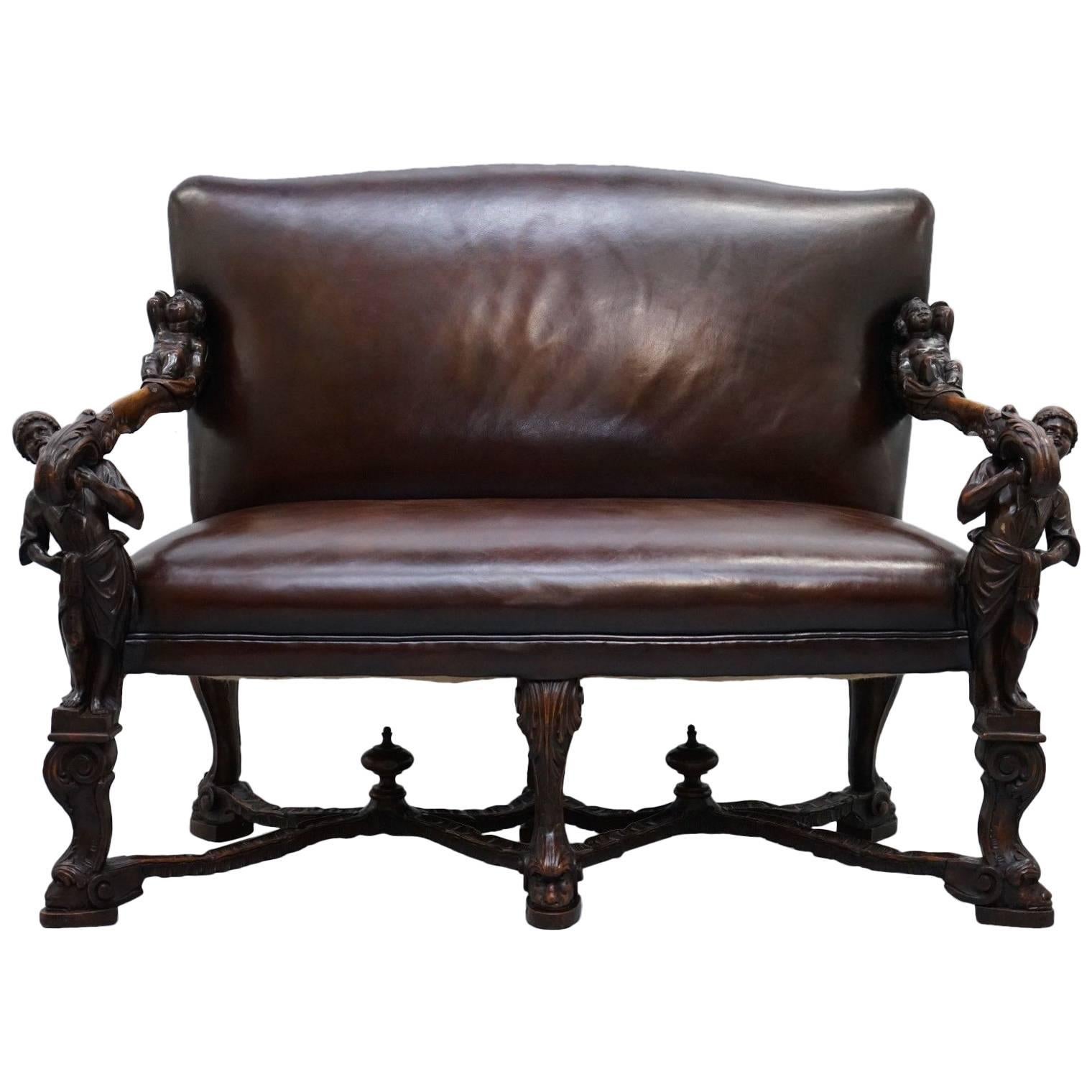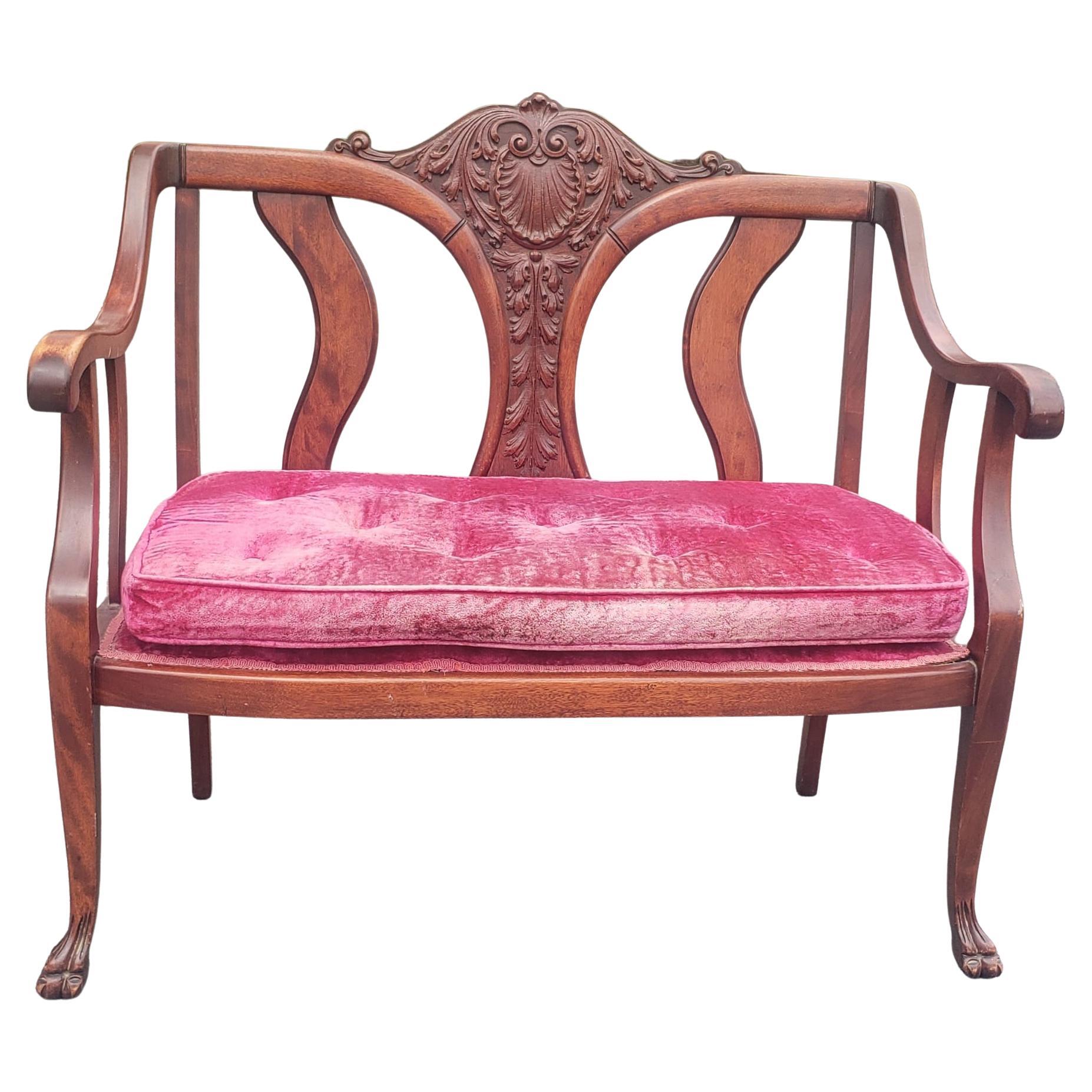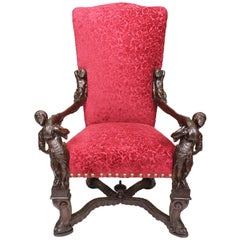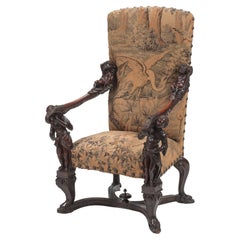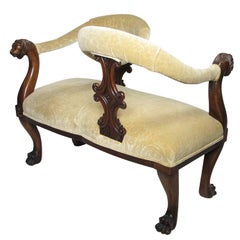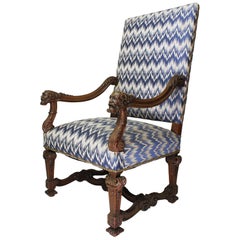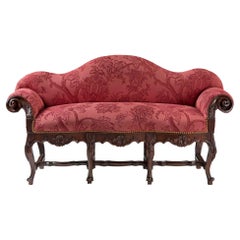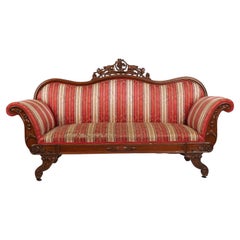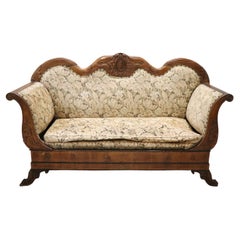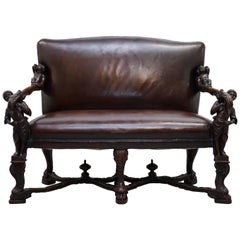Items Similar to In Manner of Andrea Brustolon Venetian 19th Century Carved Walnut Figural Settee
Video Loading
Want more images or videos?
Request additional images or videos from the seller
1 of 21
In Manner of Andrea Brustolon Venetian 19th Century Carved Walnut Figural Settee
$19,850
$38,45048% Off
£15,164.36
£29,373.7848% Off
€17,420.32
€33,743.6448% Off
CA$28,419.90
CA$55,050.1448% Off
A$31,088.15
A$60,218.6248% Off
CHF 16,197.34
CHF 31,374.6948% Off
MX$374,060.33
MX$724,565.2248% Off
NOK 205,117.70
NOK 397,318.6748% Off
SEK 192,585.86
SEK 373,044.1548% Off
DKK 130,087.04
DKK 251,982.1948% Off
About the Item
A fine and rare Italian 19th century Baroque style carved walnut figural settee (Sofa-Loveseat), attributed to Valentino Panciera Besarel (Venice, 1829-1902) in the manner of Andrea Brustolon (1662-1732). The ornately carved frame flanked on each side by Venetian male figures, each supporting an armrest, the top of the foliate armrest carved with a figure of resting Putto, raised on six cabriolet legs with carvings of male masks, all conjoined with X stretchers topped with finials. Upholstered in a recent red-burgundy damask, Venice, circa 1870.
VIDEO NOTE: Please note that the video shows this settee together with a matching throne armchair which is being offered and sold separately on 1stDibs.
Height: 53 1/8 inches (134.9 cm)
Width: 64 1/2 inches (163.8 cm)
Depth: 29 3/4 inches (75.6 cm)
Seat height: 22 inches (55.9 cm).
Biography
He was trained in a vigorous local tradition of sculpture in his native Belluno, in the Venetian terraferma, and in the studio of the Genoese sculptor Filippo Parodi, who was carrying out commissions at Padua and at Venice (1677). He spent the years 1678-80 at Rome, where the High Baroque sculpture of Bernini and his contemporaries polished his style. Apart from that, the first phase of Brustolon's working career was spent in Venice, 1680–1685. Brustolon is documented at several Venetian churches where he executed decorative carving in such profusion that he must have quickly assembled a large studio of assistants. As with his contemporary in London, Grinling Gibbons almost all the high quality robust Baroque carving in Venice has been attributed to Brustolon at one time or another. In the Venetian Ghetto, at the Scola Levantina, Brustolon provided the woodwork for the synagogue on the piano nobile, where the carved, canopied bimah is supported on Solomonic columns, which Brustolon had seen in Bernini's baldacchino in the Basilica of St Peter's.
His furniture included armchairs with figural sculptures that take the place of front legs and armrest supports, inspired by his experience of Bernini's Cathedra Petri. The gueridon, a tall stand for a candelabrum, offered Brustolon unhampered possibilities for variations of the idea of a caryatid or atlas: the familiar Baroque painted and ebonized figural gueridons, endlessly reproduced since the eighteenth century, found their models in Brustolon's work.
His secular commissions from Pietro Venier, of the Venier di San Vio family (a suite of forty sculptural pieces that can be seen in the Sala di Brustolon of the Ca' Rezzonico, Venice), from the Pisani of Strà, and from the Correr di San Simeone families encourage the attribution to him of some extravagantly rich undocumented moveable furniture. Andrea Brustolon's elaborate carved furniture aspired towards the condition of sculpture, such as the Dutch bases for console tables which look like enlargements of the work of the two Van Vianens, Paulus and Adam, perhaps the greatest Dutch silversmiths of the period. These carved pieces display the baroque tendency to develop a form three-dimensionally in space.
Brustolon's walnut, boxwood and ebony pieces transcend ordinary functional limitations of furniture; they are constructed of elaborately carved figures. The framework of Brustolon's chairs, side tables and gueridons were carved as gnarled tree branches, with further supports of putti and male figures carved in ebony. Backrests of the chairs, which were never touched in the rigidly upright posture that contemporary etiquette demanded, were carved with allegories of vanity, fire and music, etc.
The most extravagant piece delivered for Pietro Venier was a large side table and vase-stand of box and ebony, designed as a single ensemble to display rare imported Japanese porcelain vases. The eclectic allegories include Hercules with the Hydra and Cerberus, males and reclining river-gods (see ref.).
For the Correr, less extrovert chairs bear female nudes extended along the armrests. For the Pisani, he carved a suite of twelve chairs (now at the Palazzo Quirinale) with flowers, fruit, leaves and branches to symbolize the twelve months of the year. Work by Brustolon is at the Villa Pisani at Stra.
In 1685 Brustolon returned to the house where he was born at Belluno, and from that time devoted himself mainly to tabernacles and devotional sculptures in walnut, boxwood or ivory. His polychromed ivory Corpus from a crucifix is in the Museo Civico di Belluno, which preserves some of Brustolon's preparatory drawings for frames to be carved with putti displaying emblems. A pair of boxwood sculptures, The Sacrifice of Abraham and Jacob Wrestling with the Angel, integral with scrolling barocchetto stands, were in the collection of Justus Liebig (Liebigshaus, Frankfort). An altarpiece, c. 1720, is at the Victoria and Albert Museum, London.
He died in Belluno in 1732.
Valentino Panciera Besarel (1829-1902) was Andrea Brustolon's great heir of the Nineteenth Century in wood carving; he presented himself as Brustolon's natural successor and alter ego. He studied from 1855 to 1857 in Venice and his career developed the most in there and in Belluno, although it was also turned to countries beyond the Alps. He applied in furniture and in ecclesiastical and secular decoration, showing his talents in furniture and frames making.
References:
Catalogue by Massimo de Grassi, Valentino Panciera Besarel, Verona, 2002) and was the subject of a monograph, Giovanni Angelini, Gli Scultori Panciera Besarel (Belluno 2002).
Biasuz G., and Buttignon M.G., 1969. Andrea Brustolon (Istituto Veneto Arti Grafiche) 1969
Gonzales-Palacios, Alvar, 1967. Il mobilio del '700 veneto
Semenzato, G., 1967. La scultura veneta del Seicento e del Settecento (Turin: Alfieri)
Valcanover, F., 1960. Indice delle opere d'arte della città e provincia di Belluno (Venice)
Biasuz, G., and E. Lacchin, 1928. Brustolon, preface by U. Ometti (Venice: Zanetti).
- Attributed to:Valentino Panciera Besarel (Designer)
- Similar to:Andrea Brustolon (Cabinetmaker)
- Dimensions:Height: 53.13 in (134.96 cm)Width: 64.5 in (163.83 cm)Depth: 29.75 in (75.57 cm)Seat Height: 22 in (55.88 cm)
- Style:Baroque (In the Style Of)
- Materials and Techniques:
- Place of Origin:
- Period:
- Date of Manufacture:circa 1870
- Condition:Reupholstered. Wear consistent with age and use. Minor losses. Minor fading. A truly beautiful and impressive settee. Fabric is recent. Frame has age wear and minor losses. Overall condition is very good. Please view all images.
- Seller Location:Los Angeles, CA
- Reference Number:Seller: Ref.: A24071stDibs: LU1796215104031
About the Seller
5.0
Vetted Professional Seller
Every seller passes strict standards for authenticity and reliability
Established in 1982
1stDibs seller since 2016
136 sales on 1stDibs
Typical response time: <1 hour
- ShippingRetrieving quote...Shipping from: Los Angeles, CA
- Return Policy
Authenticity Guarantee
In the unlikely event there’s an issue with an item’s authenticity, contact us within 1 year for a full refund. DetailsMoney-Back Guarantee
If your item is not as described, is damaged in transit, or does not arrive, contact us within 7 days for a full refund. Details24-Hour Cancellation
You have a 24-hour grace period in which to reconsider your purchase, with no questions asked.Vetted Professional Sellers
Our world-class sellers must adhere to strict standards for service and quality, maintaining the integrity of our listings.Price-Match Guarantee
If you find that a seller listed the same item for a lower price elsewhere, we’ll match it.Trusted Global Delivery
Our best-in-class carrier network provides specialized shipping options worldwide, including custom delivery.More From This Seller
View AllIn Manner of Andrea Brustolon Venetian 19th Century Carved Walnut Figural Throne
By Valentino Besarel, Andrea Brustolon
Located in Los Angeles, CA
A fine Italian 19th century Baroque style carved walnut figural throne armchair, attributed to Valentino Panciera Besarel (Venice, 1829-1902) in the manner of Andrea Brustolon...
Category
Antique 19th Century Italian Baroque Armchairs
Materials
Fabric, Walnut
$12,950 Sale Price
29% Off
In Manner of Andrea Brustolon Venetian 19th Century Carved Walnut Figural Throne
By Valentino Panciera Besarel
Located in Los Angeles, CA
A fine Italian 19th century baroque revival style carved walnut figural throne armchair, attributed to Valentino Panciera Besarel (Venice, 1829-1902) in the manner of Andrea Brustolo...
Category
Antique Late 19th Century Italian Baroque Revival Armchairs
Materials
Tapestry, Walnut
$9,850 Sale Price
46% Off
19th Century Victorian Mahogany "Tête-à-Tête" (Head to Head) Lovers Settee
Located in Los Angeles, CA
A very fine and rare English 19th Century Victorian mahogany "Tête-à-Tête" (Head to head) Lovers or Kissing Settee, The rounded arched crests over S-shape...
Category
Antique 19th Century English Victorian Settees
Materials
Mahogany
$8,750 Sale Price
27% Off
Fine French 19th Century Louis XIV Style Baroque Carved Walnut Throne Armchair
Located in Los Angeles, CA
A fine French 19th century Louis XIV style Baroque Revival carved walnut throne armchair. The upholstered back and seat frame with open scrolled and carved armrests with carvings of ...
Category
Antique Late 19th Century French Baroque Revival Armchairs
Materials
Fabric, Walnut
Fine Country French Louis XV Style Carved Walnut and Needlepoint Armchair
Located in Los Angeles, CA
A fine Country French 19th-20th century Louis XV style carved walnut Fauteuil à la Reine armchair. The finely carved wood frame with open scrolled armrests and cabriolet legs, uphols...
Category
Antique Early 1900s French French Provincial Armchairs
Materials
Tapestry, Walnut
$3,880 Sale Price
20% Off
A French 19th C. Baroque Revival Style Carved Walnut Needlepoint Throne Armchair
Located in Los Angeles, CA
A Fine French 19th-20th Century Baroque Revival Style Parcel-Gilt Carved Walnut and Needlepoint Upholstered Hall Throne Armchair with raised carved scrolled armrests and fluted conjo...
Category
Antique Early 1900s French Baroque Revival Armchairs
Materials
Wool, Walnut
You May Also Like
French 18th Century Louis XV Period Walnut Child’s Settee
Located in West Palm Beach, FL
A charming small scale French 18th century Louis XV period walnut child's settee. The settee is raised by eight cabriole legs with fine scrolled feet and attached by a most decorativ...
Category
Antique 18th Century French Louis XV Settees
Materials
Walnut
Period Antique American Victorian Rococo Revival Carved Walnut Sofa Circa 1850
Located in Los Angeles, CA
Period Antique American Victorian Rococo Revival Bench Sofa With Classical Victorian Hand Carved Scrolled Arms and Feet and Pierced Carved Crest Rail. Solid Walnut Hardwood Construction and Hand Dovetailed Joinery. Eight way hand tied seat foundation. A very solid, quality hand made piece of history - all in very good condition (excluding the fabric upholstery which is badly worn).
Provenance: Purchased From the Estate of Larry Flynt...
Category
Antique Mid-19th Century American Rococo Revival Sofas
Materials
Fabric, Hardwood
19th Century Italian Charles X Carved Walnut Antique Large Settee
Located in Casale Monferrato, IT
Antique settee 1825s in full Charles X era. The settee is made of solid walnut hand carved. Particular shape called a boat. Large size compared to other ...
Category
Antique 1820s Italian Charles X Sofas
Materials
Walnut
$9,484 Sale Price
20% Off
Andrea Brustolon Carved Venetian Baroque Walnut Settee Sofa Bench Brown Leather
By Valentino Besarel, Andrea Brustolon
Located in West Sussex, Pulborough
We are delighted to offer for sale this very rare finely carved Venetian Baroque style figural walnut throne settee or bench, attributed to Valentino Panciera Besarel (Venice, 1829-1902) in the manner of Andrea Brustolon...
Category
Antique 1850s Italian Baroque Settees
Materials
Leather, Walnut
$38,132 Sale Price
30% Off
Early 20th Century Victorian Style Carved Mahogany and Upholstered Settee
Located in Germantown, MD
An Early 20th Century Victorian Style Carved Mahogany and Upholstered Settee with impressive center back carving.
Measures 41" in width, 23" in depth and stands 37.75" tall at the ba...
Category
Early 20th Century American Victorian Settees
Materials
Upholstery, Mahogany
Italian 18th Century Rococo Carved Walnut Sofa or Canape
Located in Berlin, DE
Italian 18th century rococo carved walnut sofa or canape
Standing on four cabriole legs with stylized foliage a carved rocaille shaped apron with a padded seat. The padded back with a carved wooden frame decorated with acanthus leaf scrolls and a cresting centered by a large rocaille.
The carving presents elegance and movement in a vivid manner with powerful rocaille carving as is characteristic of Italian Rococo furniture...
Category
Antique 1760s Italian Rococo Canapes
Materials
Walnut
More Ways To Browse
19th Century Two Seater Sofa
Alps Furniture
Carved Sofa Walnut Antique
Venetian Fabrics
Rare Japanese Porcelain
Grinling Gibbons
Console Table Bases
Figure Sofa
Baroque Style Sofa
Venetian Carved Figure
Carved Figural Settee
Ivory Crucifix
Carved Mahogany Settee
Curved Settees
Wood Back Settee
Antique Cane Settee
Settee Cushion
Double Settee
